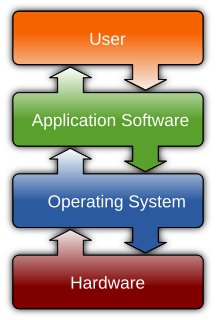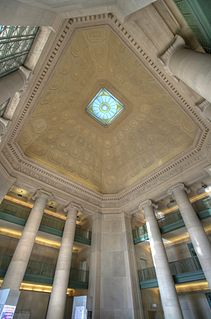External links
| This computer science article is a stub. You can help Wikipedia by expanding it. |
| Paradigm | procedural |
|---|---|
| Designed by | John Maeda |
| First appeared | 1999 |
| Stable release | 3.0.1 |
| Typing discipline | strong |
| OS | Cross-platform |
| Website | http://dbn.media.mit.edu/ |
Design By Numbers (DBN) was an influential experiment in teaching programming initiated at the MIT Media Lab during the 1990s. Led by John Maeda and his students they created software aimed at allowing designers, artists and other non-programmers to easily start computer programming. The software itself could be run in a browser and published alongside the software was a book and courseware.
Design By Numbers is no longer an active project but has gone on to influence many other projects aimed at making computer programming more accessible to non-technical people. Its most public result is Processing, created by Maeda's students Casey Reas and Ben Fry, who built on the work of DBN and has gone on to international success.
| This computer science article is a stub. You can help Wikipedia by expanding it. |

Computer software, or simply software, is a collection of data or computer instructions that tell the computer how to work. This is in contrast to physical hardware, from which the system is built and actually performs the work. In computer science and software engineering, computer software is all information processed by computer systems, programs and data. Computer software includes computer programs, libraries and related non-executable data, such as online documentation or digital media. Computer hardware and software require each other and neither can be realistically used on its own.

A computer program is a collection of instructions that can be executed by a computer to perform a specific task. Most computer devices require programs to function properly.
Hacker ethic is a term for the moral values and philosophy that are common in hacker culture. Practitioners of the hacker ethic believe that sharing information and data responsibly is beneficial and helpful. Whilst the philosophy originated at the Massachusetts Institute of Technology in the 1950s–1960s, the term hacker ethic is attributed to journalist Steven Levy as described in his 1984 book titled Hackers: Heroes of the Computer Revolution. The key points within this ethic are access, freedom of information, and improvement to quality of life. While some tenets of hacker ethic were described in other texts like Computer Lib/Dream Machines (1974) by Ted Nelson, Levy appears to have been the first to document both the philosophy and the founders of the philosophy.

Lisp machines are general-purpose computers designed to efficiently run Lisp as their main software and programming language, usually via hardware support. They are an example of a high-level language computer architecture, and in a sense, they were the first commercial single-user workstations. Despite being modest in number, Lisp machines commercially pioneered many now-commonplace technologies, including effective garbage collection, laser printing, windowing systems, computer mice, high-resolution bit-mapped raster graphics, computer graphic rendering, and networking innovations such as Chaosnet. Several firms built and sold Lisp machines in the 1980s: Symbolics, Lisp Machines Incorporated, Texas Instruments, and Xerox. The operating systems were written in Lisp Machine Lisp, Interlisp (Xerox), and later partly in Common Lisp.
The hacker culture is a subculture of individuals who enjoy the intellectual challenge of creatively overcoming limitations of software systems to achieve novel and clever outcomes. The act of engaging in activities in a spirit of playfulness and exploration is termed "hacking". However, the defining characteristic of a hacker is not the activities performed themselves, but the manner in which it is done and whether it is something exciting and meaningful. Activities of playful cleverness can be said to have "hack value" and therefore the term "hacks" came about, with early examples including pranks at MIT done by students to demonstrate their technical aptitude and cleverness. Therefore, the hacker culture originally emerged in academia in the 1960s around the Massachusetts Institute of Technology (MIT)'s Tech Model Railroad Club (TMRC) and MIT Artificial Intelligence Laboratory. Hacking originally involved entering restricted areas in a clever way without causing any major damages. Some famous hacks at the Massachusetts Institute of Technology were placing of a campus police cruiser on the roof of the Great Dome and converting the Great Dome into R2-D2.
Software development is the process of conceiving, specifying, designing, programming, documenting, testing, and bug fixing involved in creating and maintaining applications, frameworks, or other software components. Software development is a process of writing and maintaining the source code, but in a broader sense, it includes all that is involved between the conception of the desired software through to the final manifestation of the software, sometimes in a planned and structured process. Therefore, software development may include research, new development, prototyping, modification, reuse, re-engineering, maintenance, or any other activities that result in software products.

Harold "Hal" Abelson is a professor of electrical engineering and computer science at the Massachusetts Institute of Technology (MIT), a fellow of the Institute of Electrical and Electronics Engineers (IEEE), and a founding director of both Creative Commons and the Free Software Foundation.

The MIT Media Lab is a research laboratory at the Massachusetts Institute of Technology, growing out of MIT's Architecture Machine Group in the School of Architecture. Its research does not restrict to fixed academic disciplines, but draws from technology, media, science, art, and design. As of 2014, Media Lab's research groups include neurobiology, biologically inspired fabrication, socially engaging robots, emotive computing, bionics, and hyperinstruments.

Project Athena was a joint project of MIT, Digital Equipment Corporation, and IBM to produce a campus-wide distributed computing environment for educational use. It was launched in 1983, and research and development ran until June 30, 1991, eight years after it began. As of 2017, Athena is still in production use at MIT. It works as software that makes a machine a thin client, that will download educational applications from the MIT servers on demand.

Application software is a program or group of programs designed for end users. Examples of an application include a word processor, a spreadsheet, an accounting application, a web browser, an email client, a media player, a file viewer, simulators, a console game or a photo editor. The collective noun application software refers to all applications collectively. This contrasts with system software, which is mainly involved with running the computer.

Computer Science & Engineering (CSE) is an academic program at some universities that integrates the fields of computer engineering and computer science, providing knowledge of computing systems in both hardware and software design. The study program is modeled on German technical universities, where CS, CE and IT are treated as respectively the theoretical, technical and practical part of one field called "Informatik".

Processing is an open-source graphical library and integrated development environment (IDE) built for the electronic arts, new media art, and visual design communities with the purpose of teaching non-programmers the fundamentals of computer programming in a visual context.

Gregor Kiczales is an American computer scientist. He is currently a full time professor of computer science at the University of British Columbia in Vancouver, British Columbia, Canada. He is best known for developing the concept of aspect-oriented programming, and the AspectJ extension to the Java programming language, both of which he designed while working at Xerox PARC. He is also one of the co-authors of the specification for the Common Lisp Object System, and is the author of the book The Art of the Metaobject Protocol, along with Jim Des Rivières and Daniel G. Bobrow.

Jack Bonnell Dennis is a computer scientist and Emeritus Professor of Computer Science and Engineering at Massachusetts Institute of Technology.
The ProgramByDesign project is an outreach effort of the PLT research group. The goal is to train college faculty, high school teachers, and possibly even middle school teachers, in programming and computing.

John Maeda is an American executive, designer, technologist. His work explores the area where business, design, and technology merge to make space for the "humanist technologist." He is EVP Chief Experience Officer at Publicis Sapient where he helps established companies transform digitally by bridging business strategy and engineering-at-scale with computational design.

The MIT School of Architecture and Planning is one of the five schools of the Massachusetts Institute of Technology, located in Cambridge, Massachusetts. Founded in 1865 by William Robert Ware, the School offered the first formal architectural curriculum in the United States, and the first architecture program in the world operating within the establishment of a University. MIT SAP is considered a global academic leader in the design fields and one of the most prestigious schools in the world. MIT's Department of Architecture has consistently ranked among the top architecture/built environment schools in the world, and from 2015-2018 was ranked highest in the world in QS World University Rankings. In 2019, it was ranked second to The Bartlett but regained the number one position in the 2020 rankings.
Computer-aided architectural engineering (CAAE) is the use of information technology for architectural engineering, in tasks such as the analysis, simulation, design, manufacture, planning, diagnosis and repair of architectural structures. CAAE is a subclass of computer-aided engineering. The first Computer-aided architectural design was written by the 1960s. It helped architectures very much that they do not need to draw blueprints. Computer-aided design also known as CAD was the first type of program to help architectures but since it did not have all the features, Computer-aided architectural engineering created as a specific software with all the tools for design.
In software engineering, a software development process is the process of dividing software development work into distinct phases to improve design, product management, and project management. It is also known as a software development life cycle (SDLC). The methodology may include the pre-definition of specific deliverables and artifacts that are created and completed by a project team to develop or maintain an application.